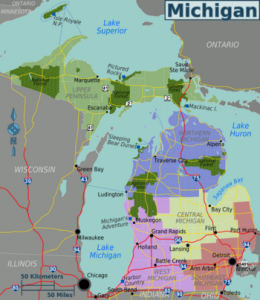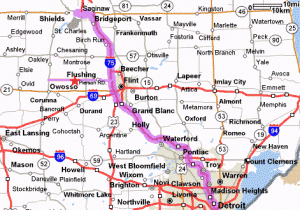I’ve been very touched reading all the comments about Detroit and different industrial cities in my intro post. As I mentioned in comments, I’m going to be doing a short background post on Detroit and Michigan to provide context for later discussions–but you should definitely read the comments on the intro post as well. They give a lot of background on so many of the issues I’ll be covering–and the great thing is, so many of those comments come from a place of deep love.
So let’s begin! As mentioned, I wanted to do a quick layout of the area I’ll be most centered on, Southeast Michigan. Please be forewarned, it is not in my capacity to do a culminative historical reading of the region. I am going to keep my perspective here narrowed down to what I feel are a few moments that still effect how the region works today.
First: Here is a picture of Michigan, a state located in the US. It has different regions highlighted. The area I’m most interested in are the ones in the Southeast (lower right hand side), or the areas highlighted yellow and red. 
Michigan is first and foremost, land that was stolen from Indigenous peoples, specifically the Fox and Sauk, the Kickapoo, the Menominee, the Miami, the Ojibwe, and the Potawatomi tribe. There are currently eleven federally recognized tribes in Michigan, here’s a link to information about seven of them.
The wars and politics that allowed for the the theft of Native land to happen are too intricate to deal with here, but the important things to note are that: 1. It was the French, English and US that all had a hand in the theft. And 2. These nation/states targeted the land they stole because of the rich resources it held and the strategic geographical location of Michigan in efficiently transporting the resources “back home.” The importance of those resources to these nation/states is demonstrated by the forts all up and down the eastern side of Michigan–forts that are not on the west side of the state. But of course, the West side shares a lake with other US states, not another nation/state.
It’s important to know about Michigan’s history of colonization because indigenous peoples in Michigan are still still struggling with the vestiges of colonization. They are also leaders in the fight against corporate violence against the land and the people. There is often a false idea that the violences of industrialization play out almost exclusively in urban areas. But those serene lakes and beautiful mountains we all like going to for our week vacation are the same places that keep the urban factories up and running.
Now, let’s jump forward a couple of hundred years to the 1950s and the construction of I-75. The I-75 corridor is an interstate freeway that runs from Sault St. Marie in the Upper Penninsula to somewhere in Florida. It should come as no surprise that Sault St. Marie is land stolen from Native peoples. And it is also no coincidence that it is a major shipping port that is home to the famous Soo Locks, a series of locks within a canal that allows heavy industry tankers to travel the difficult area of the Great Lakes. It should be no surprise that I-75 also connects all the major factory cities in Michigan together (Saginaw, Flint, Dearborn, Detroit).
Here is a close up map that highlights the 1-75 corridor in Southeast Michigan:

So the question you should be asking yourself right now is why does I-75 seem to follow a straight line through all the industrial cities on the East side of Michigan–rather than, say, all the religious cities on the West side?
To get to that answer–so we need to jump back a few years to the 1930s and 40s in Detroit (bear with me, I’m almost done!).
The Big Three are a Very Big Deal in this area. Chrysler, General Motors, and Ford are who historically have supplied the majority of the jobs throughout the region, and even today after NAFTA and CAFTA and all the other free trade agreements the US has entered into, a huge population of the available jobs in the Michigan are connected to the Big Three. Usually these days it’s through the supply side. That is, rather than building the cars, the jobs across the state are related to piecing together *parts* of the cars–like: window panels, door handles, etc. I knew somebody who put herself through college making rear view mirrors. I know somebody else who spent his college years working at a factory that builds air filtration systems for the bigger factories.
But at one point, the majority of the jobs were in huge factories up and down the I-75 corridor. At one point, Buick City in Flint had over 27,000 workers alone. And those jobs were the major incentive behind what’s known as the Great Migration (which generally spanned from the 20s until the 50s). During the Great Migration, a vast majority of the migrating people (which were largely made up of black folks and poor white folks from the mining areas) settling in Michigan settled on the East side of the state–or, along the factory belt line where all the jobs were.
During that time, there was prosperity. But not all was well. For all intents and purposes, Flint and Detroit (among others) were not just factory towns, as in: there was a factory in the city, but were *factory* towns, as in: spies and threats of violence and corporate control over the government and police. There were unions, but with the organization of those unions came the real threat of death. There was money, but in especially Detroit, there were few places to spend it. There were jobs–but those jobs were segregated. Whites getting the less dangerous jobs, black men getting the most dangerous. There were unions, but men rarely fought for the concerns union women had.
It was the 40s that PalMD notes in comments was the peak era of the region. But it was also the era that marked the beginning of post-industrialization in the Rust Belt. I’m going to get in specific details of the 1940s Detroit (the Arsenal of Democracy) era in my next post. Because 1940s Detroit is the reason that we should all care about what is going on in Detroit right now–and I would argue that it’s the reason we should all care about post-industrialization, globalization, heavy industry, the Rust Belt–and what Detroiters specifically and Michiganders in general are doing to confront the mess the corporations left behind. It’s also exemplifies exactly how white supremacist heteropatriarchy is a function of capitalism and vise versa, and why gender justice will not happen, in fact, can not happen, without addressing the entire mess of it.
But for now, just notice how the different pieces of Michigan history intersect with each other: colonization, resource grabs, transportation of resources, and government complicity with corporations.
Ok–well, that’s it for the “short” history. 😀
I’d love to hear from others what their geographical history looks like!